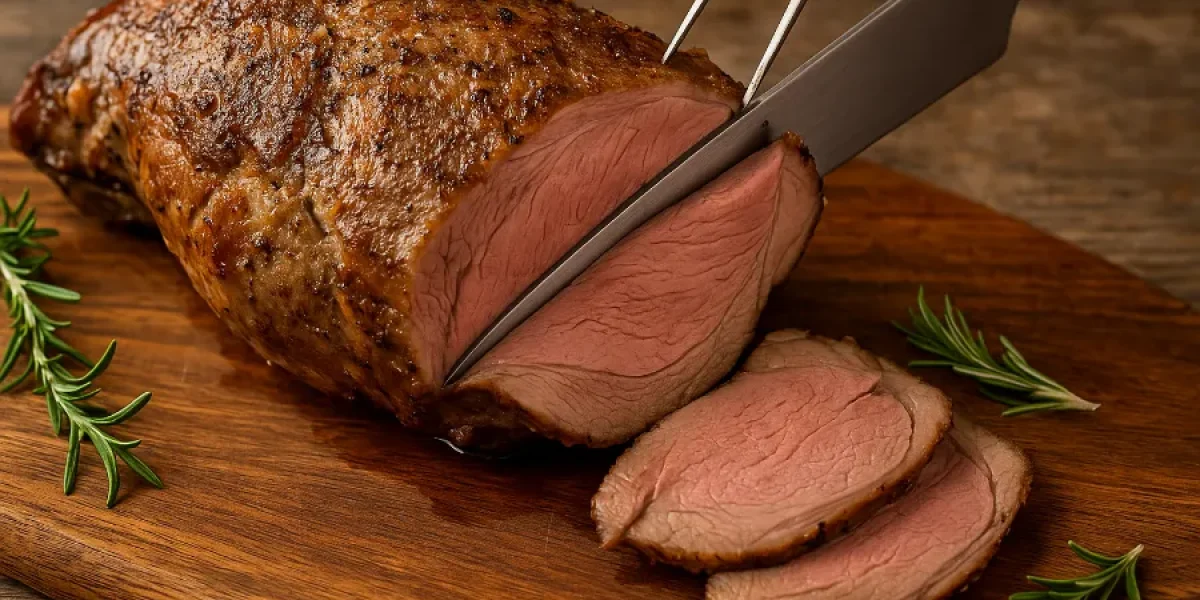If there’s one lesson I’ve learned after years of Sunday roasts, it’s this — the secret to perfect lamb isn’t just in the rub, or the herbs, or even the oven. It’s in the internal temperature for lamb leg.
That single number on your thermometer determines everything — the tenderness, the juiciness, even the way the fat melts across the meat. It’s what separates an okay roast from a jaw-dropping centerpiece that makes everyone at the table stop talking mid-bite.
In this post, I’ll walk you through exactly what temperatures you should be aiming for, how to adjust your oven for different results, and a few personal tricks that make the process easier (and a lot more forgiving).
Roast Lamb Temperature: Setting the Stage for Success
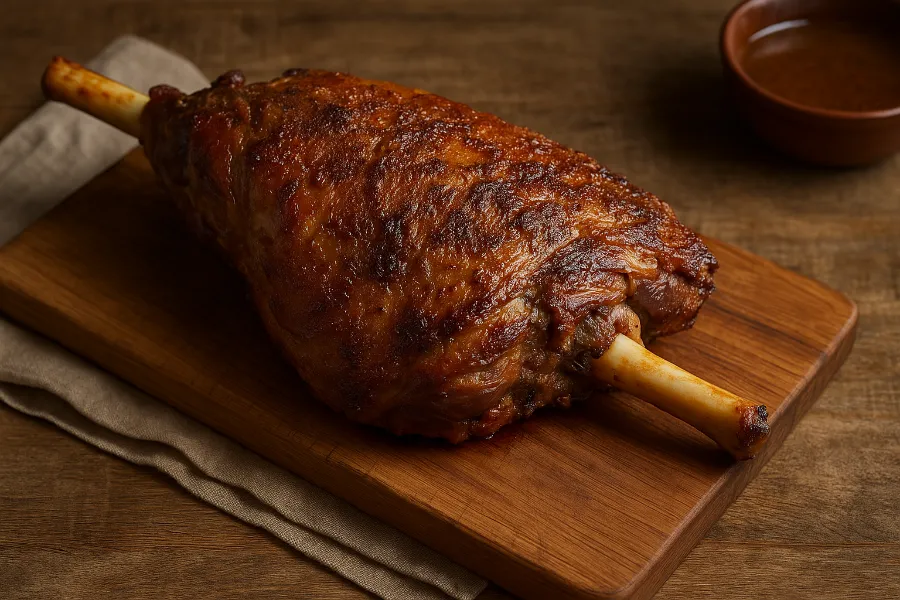
Before we even talk about the internal temp, let’s set the oven right. The roast lamb temperature controls how quickly heat moves from the outside to the center — and getting that balance right is half the battle.
My golden rule: start high, then go slow.
Here’s the breakdown I swear by:
- Start at 450°F (230°C) for 15 minutes. This step caramelizes the outer layer and seals in flavor.
- Then reduce to 325°F (165°C) for the remainder of the roast. That lower heat allows the meat to cook evenly without drying out.
If you skip that first high-heat blast, your lamb can look pale and lack that crave-worthy crust. Too hot for too long, though, and you’ll end up with dry edges before the center is done. So: sear first, then slow it down.
This two-temperature approach gives you the best of both worlds — deep browning on the outside and a beautifully pink, tender interior.
Internal Temperature for Lamb Leg: The Numbers That Matter
Once your lamb is in the oven, forget the clock for a moment. Your thermometer is your true north.
Here’s the range to keep in mind, depending on how you like your roast:
| Doneness | Internal Temp (°F) | Notes |
|---|---|---|
| Rare | 120–125°F | Deep pink center, very juicy |
| Medium Rare | 130–135°F | Perfect balance of tenderness and flavor |
| Medium | 140–145°F | Slightly pink, more structured texture |
| Medium Well | 150–155°F | Almost fully cooked, still moist |
| Well Done | 160°F+ | Fully cooked, lean and firm |
If you’re new to roasting lamb, aim for 130–135°F. It’s forgiving, flavorful, and nearly impossible to ruin.
💡 Pro tip: Take your lamb out of the oven about 5°F before it reaches your target temperature. The heat will continue to rise as it rests. This “carryover cooking” ensures a juicy center without overdoing it.
Medium Rare Lamb Temperature: The Sweet Spot
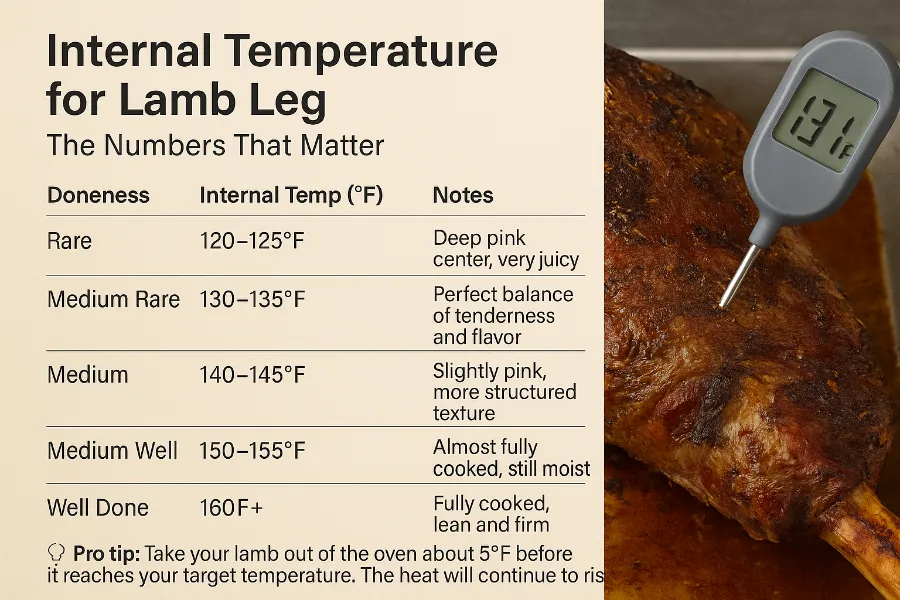
If you ask me (and most chefs would agree), the medium rare lamb temperature is where magic happens — between 130°F and 135°F.
At this stage:
- The color is a soft blush pink.
- The fat melts enough to keep the meat moist.
- The texture is buttery but still sliceable.
You’ll get that savory, slightly gamey richness that makes lamb stand out from other roasts — without losing any of its moisture.
Whenever I’m serving guests, medium rare is my go-to. It pleases everyone at the table — those who like a bit of pink and those who don’t want it too rare.
How Long to Roast a Leg of Lamb
So, how long does it take to hit that perfect internal temperature? It depends on the cut and the oven. But here’s a general guide that’s never failed me:
| Cut | Weight | Oven Temp | Approx. Time | Target Internal Temp |
|---|---|---|---|---|
| Bone-In Leg of Lamb | 5–7 lbs | 325°F | 20–25 min per lb | 130–135°F (medium rare) |
| Boneless Leg of Lamb | 4–5 lbs | 350°F | 18–20 min per lb | 130–135°F |
| Butterflied Leg of Lamb | 3–4 lbs | 400°F | 12–15 min per lb | 130–140°F |
Remember — these are guidelines, not rules. Ovens vary. Always trust your thermometer over the clock.
When I’m cooking for family, I insert the thermometer halfway through the thickest part of the meat, avoiding the bone. Once it’s close to 130°F, I start checking every 10 minutes. It’s worth hovering — you’ll thank yourself when you slice into that tender center later.
Slow Roasted Lamb Leg: When Time Is on Your Side
Sometimes, I like to slow things down — literally.
A slow roasted lamb leg turns a simple cut of meat into something melt-in-your-mouth amazing. It’s all about low heat and patience.
Set your oven to 300°F (150°C) and roast for 3 to 4 hours, depending on size. The slow heat gently breaks down the fibers and connective tissue, transforming the lamb into a silky, fork-tender masterpiece.
Here’s why I love this method:
- It’s nearly foolproof.
- The aroma fills your kitchen for hours.
- You can leave it alone — no frantic basting or checking every few minutes.
The internal temperature still matters — aim for 135°F if you want tender slices, or 145°F if you want it a little more cooked.
By the time you pull it out, the lamb will be resting in its own rich, herby juices. It’s the kind of dish that practically makes its own gravy.
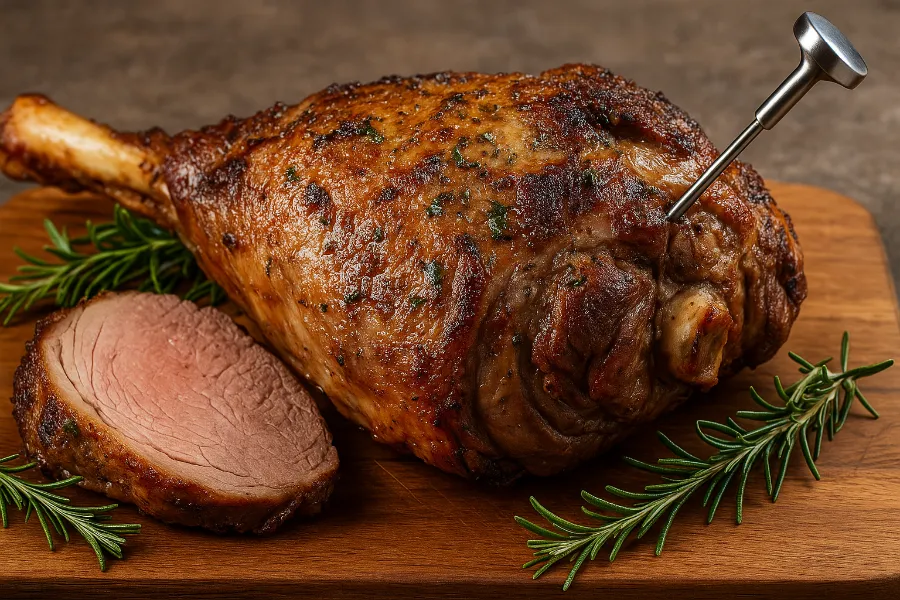
The Best Way to Cook Leg of Lamb (My Go-To Routine)
After years of testing every method — from high-heat blasts to slow oven Sundays — here’s the best way to cook leg of lamb if you want guaranteed success:
Step 1: Bring It to Room Temperature
Cold meat cooks unevenly. Let your lamb sit out for about 45 minutes before it goes in the oven.
Step 2: Score and Season
Score the fat lightly, then rub with olive oil, garlic, rosemary, thyme, salt, and pepper.
I like to push slivers of garlic deep into the meat — it perfumes the entire roast as it cooks.
Step 3: Sear High, Roast Slow
Start at 450°F (230°C) for 15 minutes, then drop to 325°F (165°C) until the internal temperature hits 130°F for medium rare.
This two-temperature process creates a crisp, flavorful crust and keeps the center tender.
Step 4: Rest and Resist
When it’s done, cover the lamb loosely with foil and let it rest for at least 15–20 minutes.
This might be the hardest step — everyone will want to slice right away — but it’s non-negotiable. Resting lets the juices settle back into the meat instead of spilling onto your board.
What I Serve With Perfectly Cooked Lamb
For me, roast lamb isn’t just about the meat — it’s about the whole experience. The sides matter as much as the centerpiece.
Here are a few pairings that never fail:
- Garlic mashed potatoes with pan drippings
- Roasted asparagus or minted peas
- Couscous with lemon zest and parsley
- A quick Greek salad for a bright, tangy balance
If you’re serving wine, a Syrah or Cabernet pairs beautifully with the earthy, savory flavors of lamb.
Checking the Internal Temperature: Common Mistakes to Avoid
Even with a thermometer, I see people trip up on these easy-to-fix issues:
- Touching the Bone: The bone heats faster than the meat, giving a false reading. Always aim for the thickest part of the meat, avoiding bone.
- Guessing Without Resting: The lamb keeps cooking even after it’s out. Pull it early — 5°F before your target.
- Skipping Rest Time: It’s tempting to carve right away, but patience keeps the juices where they belong.
A thermometer isn’t just a gadget — it’s your insurance policy against overcooked lamb.
Why Temperature Is Everything
Lamb is leaner than beef and has less marbling, which means there’s a smaller window between perfectly cooked and dry.
At 120°F, it’s underdone. At 160°F, it’s tough. Somewhere in the middle — between 130°F and 145°F — it becomes tender, aromatic, and deeply satisfying.
The internal temperature for lamb leg isn’t just a number; it’s a roadmap for flavor.
My Favorite Finishing Touch
Once the lamb rests, I often take the pan juices, whisk in a splash of wine, a dab of butter, and a squeeze of lemon. That quick sauce — glossy, tangy, and rich — ties everything together.
Pour it over the carved slices, sprinkle some flaky salt, and watch everyone reach for seconds.
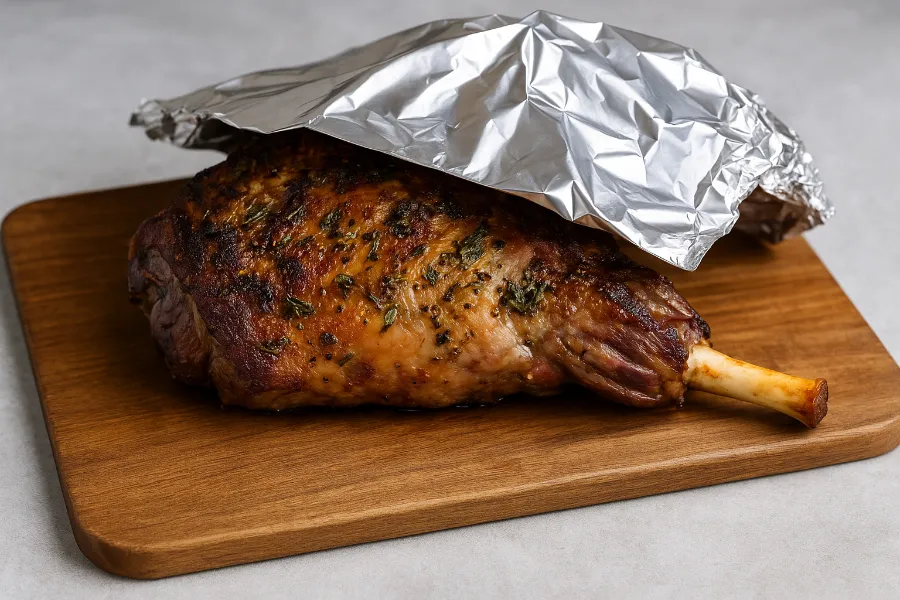
Final Thoughts: It’s All About That Temperature
Perfect roast lamb isn’t about luck or expensive cuts. It’s about control — knowing your internal temperature for lamb leg and trusting the process.
Once you learn to cook by temperature, not time, every roast becomes effortless. Whether you’re going for a slow roasted lamb leg for a holiday dinner or a quick weeknight roast, precision is the difference between “pretty good” and unforgettable.
So grab your thermometer, preheat the oven, and make your next lamb leg a masterpiece. When you slice through that rosy, tender center, you’ll know — this is the moment all that care was for.
FAQs
The ideal internal temperature for lamb leg is 130–135°F for medium rare. This range keeps the meat juicy, tender, and flavorful without drying it out.
Insert a meat thermometer into the thickest part of the leg, avoiding the bone. Check toward the end of cooking to prevent overcooking due to carryover heat.
For medium doneness, aim for 140–145°F. The meat will be slightly pink with a firmer texture but still tender and moist.
Yes, always rest the lamb for 15–20 minutes after roasting. This allows the juices to redistribute and brings the internal temperature up by about 5°F.
Absolutely. Set your oven to 300°F (150°C) and roast until the internal temperature hits 135°F. This low and slow method makes the meat extra tender and flavorful.
It typically takes 20–25 minutes per pound at 325°F for a bone-in leg. Always verify doneness by checking the internal temperature instead of relying only on time.
For well-done lamb, cook until it reaches 160°F or higher. The meat will be fully cooked through with little to no pink inside.

